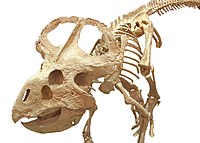
Photo from wikipedia
Ontogenetic variation of cranial characters used in crocodylian phylogenetic systematics has never been studied. Furthermore, the relationship between diet and skull morphological transformation during ontogeny has not been properly explored… Click to show full abstract
Ontogenetic variation of cranial characters used in crocodylian phylogenetic systematics has never been studied. Furthermore, the relationship between diet and skull morphological transformation during ontogeny has not been properly explored yet. We quantify the inter- and intraspecific skull morphological variation in extant caiman species focusing on those areas relevant to systematics and, also investigate the relation between diet and morphological changes during ontogeny. We applied a three-dimensional approach of geometric morphometrics on post-hatching ontogenetic cranial series of Caiman latirostris and C. yacare. In order to incorporate incomplete material, we additionally tested four different methods of missing landmark estimation and apply the thin-plate spline interpolation. We detected morphological changes between species and during ontogeny (snout and pterygoid flanges increase their proportions and, orbits, temporal fenestrae, skull roof and foramen magnum decrease their relative size) that constitutes part of a general morphological change in the cranial ontogeny of crocodylians. Moreover, the negative allometry of the fenestrae and neurocranium and the positive allometry of the splanchnocranium in both caiman species are the plesiomorphic condition, at least, for tetrapods. Shape changes during growth were found to be related to ontogenetic changes in the diet. Dissimilarities between species seem to be related to different mechanical requirements and different use of the habitat. We found inter- and intraspecific variation in some morphological characters with systematic implications (the contact of nasals with naris, the contact of prefrontals in the midline, and the bones that border the suborbital fenestra and the proportion in which one of them participates) that are not currently considered in phylogenetic analyses.
Journal Title: Zoology
Year Published: 2018
Link to full text (if available)
Share on Social Media: Sign Up to like & get
recommendations!